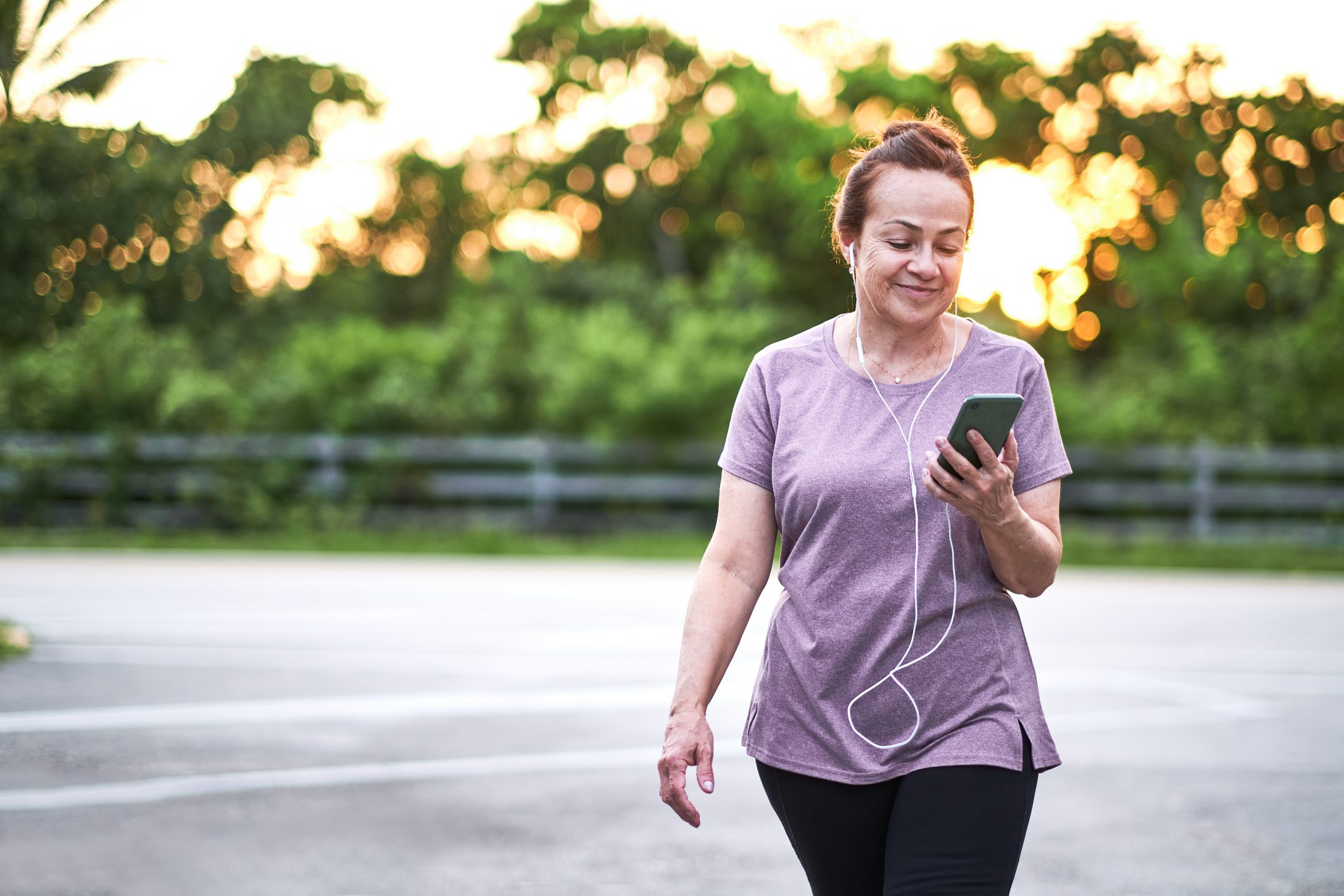If you’ve been following me for a while, you know I’m passionate about the benefits of walking. You might have thought I consider it a waste of time, but that’s far from the truth. Walking may not fit the traditional definition of exercise, which involves pushing your body beyond its usual limits to build strength. However, walking is essential for your metabolism and can play a strategic role in supporting fat loss while preserving muscle mass.
To understand why walking can help you lose weight, consider three big factors that impact your metabolism:
- Basal Metabolic Rate (BMR): The number of calories you burn at rest, influenced by age, sex, genetics, and muscle mass. Of those factors, muscle mass is the only one you can change. BMR accounts for 50-60% of your Total Daily Energy Expenditure (TDEE), or the total calories your body needs daily to maintain your current weight.1,2
- Thermic Effect of Food (TEF): The calories your body uses for digesting and processing food. The thermic effect makes up about 10% of your TDEE. Of the three macronutrients, protein has the highest TEF—your body uses 20-30% of those calories to break down, absorb, and process protein. Protein helps maintain your BMR by preserving lean tissue during fat loss.3, 4
- Activity: This includes exercise and non-exercise activity thermogenesis (NEAT). Exercise can account for 0-10% of your TDEE, depending on your activity level. NEAT, which includes all physical activity outside of formal exercise, can make up 15-30% of your TDEE.5
Increasing your NEAT can be the key to breaking through a weight loss plateau. When I refer to NEAT, I mean everything from fidgeting to taking the stairs and parking farther away. While you can’t control unconscious movements like fidgeting, you can increase your daily steps and their intensity. Let’s focus on what you can change—getting more daily steps and making them more intense.
Benefits of Increasing Daily Steps and Intensity
Most people walk about 3,000-4,000 steps each day.6 However, to see big improvements in your metabolism and weight loss, you’ll need to step things up—literally. Your goal should be to get 8,000-12,000 steps a day while adding brisk walking to your routine.7 Brisk walking is faster than usual, around 3-4.5 miles per hour.7
Two major studies highlight the benefits of walking more each day. One examined the relationship between step count and your risk of dying. The study found that people getting 8,000 steps daily had a 50% lower risk of dying from any cause than those only getting 4,000 daily. Even better, those who took 12,000 steps per day had a 65% lower risk of dying from any cause. Higher step counts also helped lower death rates from heart disease and cancer.8
The second study focused on steps and intensity among obese college students. Researchers divided participants into three groups: a Walking Step Goal Group aiming for 12,000 steps daily; a Walking Exercise Group aiming for 12,000 steps plus including three days of faster-paced walking per week, and a control group with no specific step goals.
Over eight weeks, the Walking Exercise Group experienced several significant improvements, including reduced hip circumference, decreased fat stored around internal organs, increased HDL cholesterol (the good kind), lower fasting blood-sugar levels, and lower triglycerides.
In contrast, the Walking Step Goal Group only showed improved HDL cholesterol, and the control group had no significant changes. Researchers concluded that combining a walking exercise program (including faster-paced walking days) with a daily step goal improves body composition and metabolic health more than just a daily step goal alone.9
How to Get More Steps & Increase Intensity
To maximize the benefits of walking for weight loss, focus on increasing your daily step count and the intensity of your walks.
1. Do an activity audit: Use a fitness tracker to monitor your daily steps. Make it a goal to increase your steps by 10% every few days until you reach 8,000-12,000 a day. This should be a non-negotiable part of your daily routine.
2. Switch up your routines: Incorporate more movement into your daily activities, like:
- Parking farther away from your destination.
- Walking the dog regularly.
- Taking the stairs instead of the elevator.
- Designing your environment to require more movement, like placing necessities downstairs or far from your workspace.
- Doing walking meetings instead of sitting in a conference room.
- Meeting friends for a walk rather than sitting for coffee.
- Hopping off the bus or train a stop early and walking the rest of the way.
- Take short walks after each meal to help you digest and hit your step goal.
- Complete half your daily steps before noon. This will help you stay on track.
3. Use a walking pad: Walking pads are compact, portable treadmills designed for walking at low speeds. They are perfect for small spaces and can even fit under desks, making them convenient for home or office use. I use the Urevo Walking Pad to jump on the treadmill during conference calls.
4. Add intensity: Start by walking faster to increase your heart rate. This simple adjustment can significantly improve your cardiovascular fitness and calorie burn. Incorporating hills or inclines into your walking routes can elevate your heart rate and engage different muscle groups, adding another layer of intensity to your routine.
You can also add intensity with weight. I love my rucking vest for adding resistance, supporting bone density, and increasing calorie burn. You can wear the vest while walking outdoors or around the house to keep moving and stay active.
A Powerful Combo for Fast, Lasting Fat Loss
Walking and optimal protein intake make a great fat-burning combo! The thermic effect of food (TEF)—or the energy your body uses to digest, absorb, and process the nutrients from the food—makes up about 10% of the calories you burn daily. Protein is the best at boosting TEF compared to carbs or fat.10
As we age, many of us aren’t consuming enough protein to meet our increased needs. One simple dietary change can make a significant difference: eat protein first. My 7-Day Eat Protein First Challenge provides everything you need to optimize protein intake. Use the protein calculator to determine your ideal protein intake—the results may surprise you! Plus, you’ll receive a guide with tips, tricks, and a protein-first meal plan to help you successfully transition to a higher-protein diet.
Get your FREE 7-Day Eat Protein First Challenge here.
References:
- Cleveland Clinic: Metabolism: What It Is, How It Works and Disorders
- WebMD: Metabolism: What It Does, What Affects It, and More
- Ravn AM, Gregersen NT, Christensen R, Rasmussen LG, Hels O, Belza A, Raben A, Larsen TM, Toubro S, Astrup A. Thermic effect of a meal and appetite in adults: an individual participant data meta-analysis of meal-test trials. Food Nutr Res. 2013 Dec 23;57. doi: 10.3402/fnr.v57i0.19676. PMID: 24376394; PMCID: PMC3873760.
- Healthline: How Protein Can Help You Lose Weight Naturally
- von Loeffelholz C, Birkenfeld AL. Non-Exercise Activity Thermogenesis in Human Energy Homeostasis. [Updated 2022 Nov 25]. In: Feingold KR, Anawalt B, Blackman MR, et al., editors. Endotext [Internet]. South Dartmouth (MA): MDText.com, Inc.; 2000-. Available from: https://www.ncbi.nlm.nih.gov/books/NBK279077/
- Mayo Clinic: 10,000 steps a day: Too low? Too high?
- Verywell Health: Brisk Walking: Pace, Distance, and Benefits
- Saint-Maurice PF, Troiano RP, Bassett DR Jr, Graubard BI, Carlson SA, Shiroma EJ, Fulton JE, Matthews CE. Association of Daily Step Count and Step Intensity With Mortality Among US Adults. JAMA. 2020 Mar 24;323(12):1151-1160. doi: 10.1001/jama.2020.1382. PMID: 32207799; PMCID: PMC7093766.
- Chiang TL, Chen C, Hsu CH, Lin YC, Wu HJ. Is the goal of 12,000 steps per day sufficient for improving body composition and metabolic syndrome? The necessity of combining exercise intensity: a randomized controlled trial. BMC Public Health. 2019 Sep 3;19(1):1215. doi: 10.1186/s12889-019-7554-y. PMID: 31481039; PMCID: PMC6724241.
- Pesta DH, Samuel VT. A high-protein diet for reducing body fat: mechanisms and possible caveats. Nutr Metab (Lond). 2014 Nov 19;11(1):53. doi: 10.1186/1743-7075-11-53. PMID: 25489333; PMCID: PMC4258944.
These statements have not been evaluated by the Food & Drug Administration. Products mentioned are not intended to diagnose, treat, cure, or prevent any disease. The views in this blog by JJ Virgin should never be used as a substitute for professional medical advice. Please work with a healthcare practitioner concerning any medical problem or concern.
I couldn’t make it without supportive relationships, and I bet you feel the same! That’s why my team and I offer you products and services we believe in. If you happen to purchase something I recommend here, I may receive some kind of compensation. However, I only bring you partners whose content and core values will serve you with the same commitment to excellence my team and I strive for every day. Please be in touch with any concerns.




